An Efficient Block Successive Upper-Bound Minimization Algorithm for Caching a Reconfigurable Intelligent Surface-Assisted Downlink Non-Orthogonal Multiple Access System
Abstract
1. Introduction
1.1. Existing Surveys and Contributions
1.2. Organization
2. Communication and Caching Models
2.1. Wireless Communication Model
2.2. Caching Model
3. Problem Formulation
4. Proposed Methods and Algorithms
4.1. Proposed Solution by an Efficient BSUM Algorithm
4.2. Pseudo Codes of the Proposed Algorithm
| Algorithm 1: The proposed efficient BSUM algorithm |
 |
5. Numerical Simulation Results
6. Conclusions
Funding
Data Availability Statement
Conflicts of Interest
References
- Wu, Q.; Zhang, R. Intelligent Reflecting Surface Enhanced Wireless Network via Joint Active and Passive Beamforming. IEEE Trans. Wirel. Commun. 2019, 18, 5394–5409. [Google Scholar] [CrossRef]
- Huang, C.; Zappone, A.; Alexandropoulos, G.C.; Debbah, M.; Yuen, C. Reconfigurable Intelligent Surfaces for Energy Efficiency in Wireless Communication. IEEE Trans. Wirel. Commun. 2019, 18, 4157–4170. [Google Scholar] [CrossRef]
- Tang, J.; Peng, Z.; So, D.K.C.; Zhang, X.; Wong, K.K.; Chambers, J.A. Energy Efficiency Optimization for a Multiuser IRS-Aided MISO System With SWIPT. IEEE Trans. Commun. 2023, 71, 5950–5962. [Google Scholar] [CrossRef]
- Li, D. How Many Reflecting Elements Are Needed for Energy- and Spectral-Efficient Intelligent Reflecting Surface-Assisted Communication. IEEE Trans. Commun. 2022, 70, 1320–1331. [Google Scholar] [CrossRef]
- Wang, Z.; Zhao, X.; Tang, J.; Zhao, N.; So, D.K.C.; Zhang, X.Y.; Wong, K.K. Zero-Forcing Beamforming for RIS-Enhanced Secure Transmission. IEEE Trans. Veh. Technol. 2023, 72, 13666–13670. [Google Scholar] [CrossRef]
- Tang, J.; Luo, J.; Liu, M.; So, D.K.C.; Alsusa, E.; Chen, G.; Wong, K.K.; Chambers, J.A. Energy Efficiency Optimization for NOMA With SWIPT. IEEE J. Sel. Top. Signal Process. 2019, 13, 452–466. [Google Scholar] [CrossRef]
- Tang, J.; Yu, Y.; Liu, M.; So, D.K.C.; Zhang, X.; Li, Z.; Wong, K.K. Joint Power Allocation and Splitting Control for SWIPT-Enabled NOMA Systems. IEEE Trans. Wirel. Commun. 2020, 19, 120–133. [Google Scholar] [CrossRef]
- Qi, T.; Feng, W.; Chen, Y.; Nallanathan, A. Double QoS Guarantee for NOMA-Enabled Massive MTC Networks. IEEE Internet Things J. 2022, 9, 22657–22668. [Google Scholar] [CrossRef]
- Chen, Z.; Tang, J.; Wen, M.; Li, Z.; Yang, J.; Zhang, X.Y.; Wong, K.K. Reconfigurable Intelligent Surface Assisted MEC Offloading in NOMA-Enabled IoT Networks. IEEE Trans. Commun. 2023, 71, 4896–4908. [Google Scholar] [CrossRef]
- Dai, G.; Huang, R.; Yuan, J.; Hu, Z.; Chen, L.; Lu, J.; Fan, T.; Wan, D.; Wen, M.; Hou, T.; et al. Towards Flawless Designs: Recent Progresses in Non-Orthogonal Multiple Access Technology. Electronics 2023, 12, 4577. [Google Scholar] [CrossRef]
- Li, C.; Chen, W. Content Pushing Over Idle Timeslots: Performance Analysis and Caching Gains. IEEE Trans. Wirel. Commun. 2021, 20, 5586–5598. [Google Scholar] [CrossRef]
- Li, C.; Chen, W.; Letaief, K.B. Joint Scheduling of Proactive Caching and On-Demand Transmission Traffics Over Shared Spectrum. IEEE Trans. Commun. 2021, 69, 8319–8334. [Google Scholar] [CrossRef]
- Xu, X.; Tao, M. Decentralized Multi-Agent Multi-Armed Bandit Learning With Calibration for Multi-Cell Caching. IEEE Trans. Commun. 2021, 69, 2457–2472. [Google Scholar] [CrossRef]
- Zhang, T.; Wang, Y.; Yi, W.; Liu, Y.; Nallanathan, A. Joint Optimization of Caching Placement and Trajectory for UAV-D2D Networks. IEEE Trans. Commun. 2022, 70, 5514–5527. [Google Scholar] [CrossRef]
- Hua, Y.; Fu, Y.; Zhu, Q. Latency Minimization for Advanced RSMA-Enabled Wireless Caching Networks. IEEE Wirel. Commun. Lett. 2023, 12, 1329–1333. [Google Scholar] [CrossRef]
- Wu, D.; Li, J.; He, P.; Cui, Y.; Wang, R. Social-Aware Graph-Based Collaborative Caching in Edge-User Networks. IEEE Trans. Veh. Technol. 2023, 72, 7926–7941. [Google Scholar] [CrossRef]
- Hui, H.; Chen, W. Joint Scheduling of Proactive Pushing and On-Demand Transmission Over Shared Spectrum for Profit Maximization. IEEE Trans. Wirel. Commun. 2023, 22, 107–121. [Google Scholar] [CrossRef]
- Tao, Y.; Jiang, Y.; Zheng, F.C.; Wang, Z.; Zhu, P.; Tao, M.; Niyato, D.; You, X. Content Popularity Prediction Based on Quantized Federated Bayesian Learning in Fog Radio Access Networks. IEEE Trans. Commun. 2023, 71, 893–907. [Google Scholar] [CrossRef]
- Ma, R.; Tang, J.; Zhang, X.; Wong, K.K.; Chambers, J.A. Energy-Efficiency Optimization for Mutual-Coupling-Aware Wireless Communication System Based on RIS-Enhanced SWIPT. IEEE Internet Things J. 2023, 10, 19399–19414. [Google Scholar] [CrossRef]
- Chen, Z.; Tang, J.; Zhao, N.; Liu, M.; So, D.K.C. Hybrid Beamforming With Discrete Phase Shifts for RIS-Assisted Multiuser SWIPT System. IEEE Wirel. Commun. Lett. 2023, 12, 104–108. [Google Scholar] [CrossRef]
- Chen, Z.; Tang, J.; Zhang, X.Y.; Wu, Q.; Chen, G.; Wong, K.K. Robust Hybrid Beamforming Design for Multi-RIS Assisted MIMO System With Imperfect CSI. IEEE Trans. Wirel. Commun. 2023, 22, 3913–3926. [Google Scholar] [CrossRef]
- Zhao, D.; Wang, G.; Wang, J.; Zhou, Z. Reconfigurable Intelligent Surface-Assisted Millimeter Wave Networks: Cell Association and Coverage Analysis. Electronics 2023, 12, 4270. [Google Scholar] [CrossRef]
- Chen, Y.; Wen, M.; Basar, E.; Wu, Y.C.; Wang, L.; Liu, W. Exploiting Reconfigurable Intelligent Surfaces in Edge Caching: Joint Hybrid Beamforming and Content Placement Optimization. IEEE Trans. Wirel. Commun. 2021, 20, 7799–7812. [Google Scholar] [CrossRef]
- Chu, Z.; Xiao, P.; Shojafar, M.; Mi, D.; Hao, W.; Shi, J.; Zhong, J. Intelligent-Reflecting-Surface-Empowered Wireless-Powered Caching Networks. IEEE Internet Things J. 2022, 9, 13153–13167. [Google Scholar] [CrossRef]
- Chu, Z.; Xiao, P.; Shojafar, M.; Mi, D.; Hao, W.; Shi, J.; Zhou, F. Utility Maximization for IRS Assisted Wireless Powered Mobile Edge Computing and Caching (WP-MECC) Networks. IEEE Trans. Commun. 2023, 71, 457–472. [Google Scholar] [CrossRef]
- Kandukuri, S.; Boyd, S. Optimal power control in interference-limited fading wireless channels with outage-probability specifications. IEEE Trans. Wirel. Commun. 2002, 1, 46–55. [Google Scholar] [CrossRef]
- Goldsmith, A. Wireless Communications, 1st ed.; Cambridge University Press: New York, NY, USA, 2005. [Google Scholar]
- Chi, C.Y.; Li, W.C.; Lin, C.H. Convex Optimization for Signal Processing and Communications: From Fundamentals to Applications; CRC Press: Boca Raton, FL, USA, 2017. [Google Scholar]
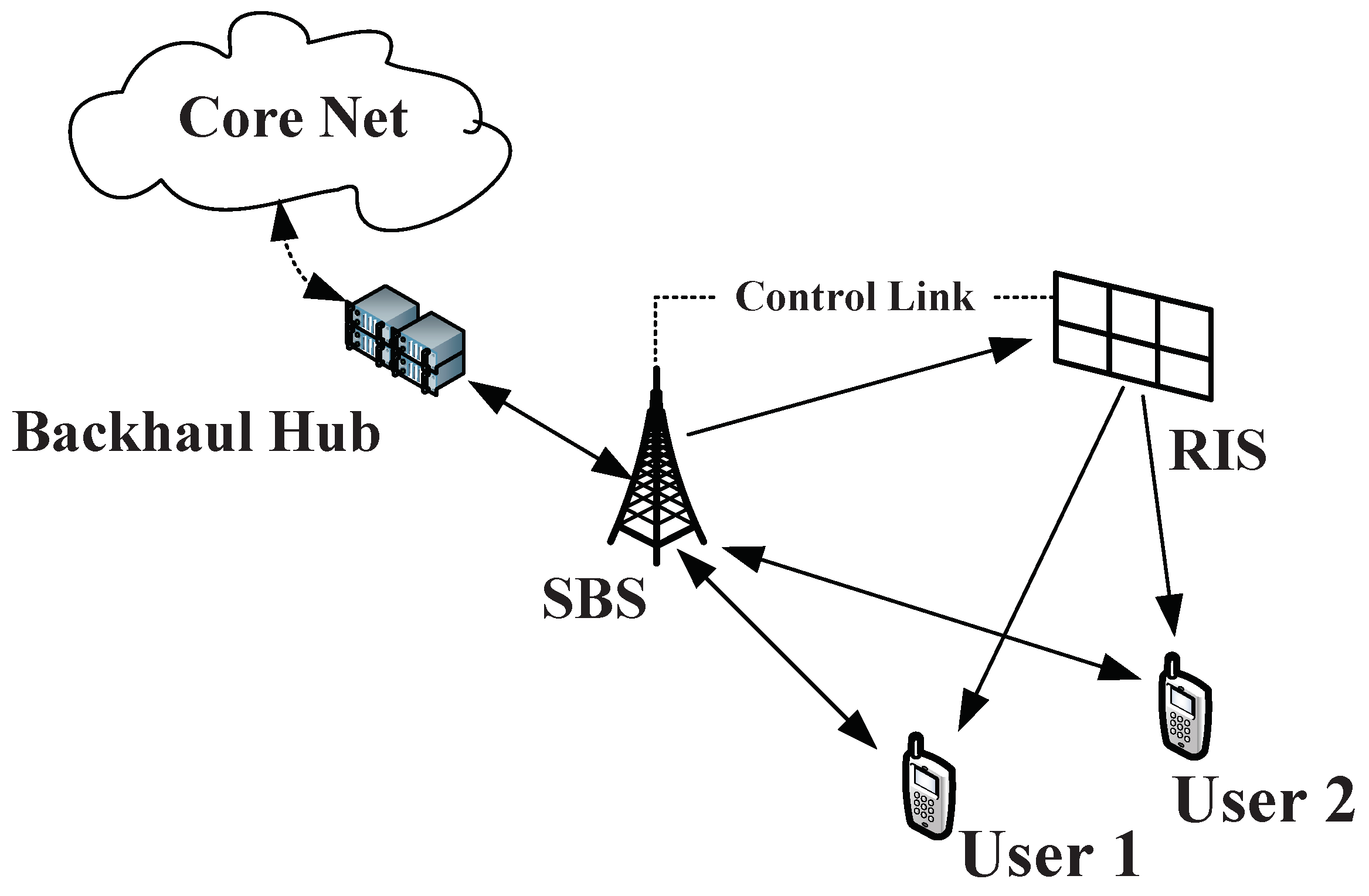
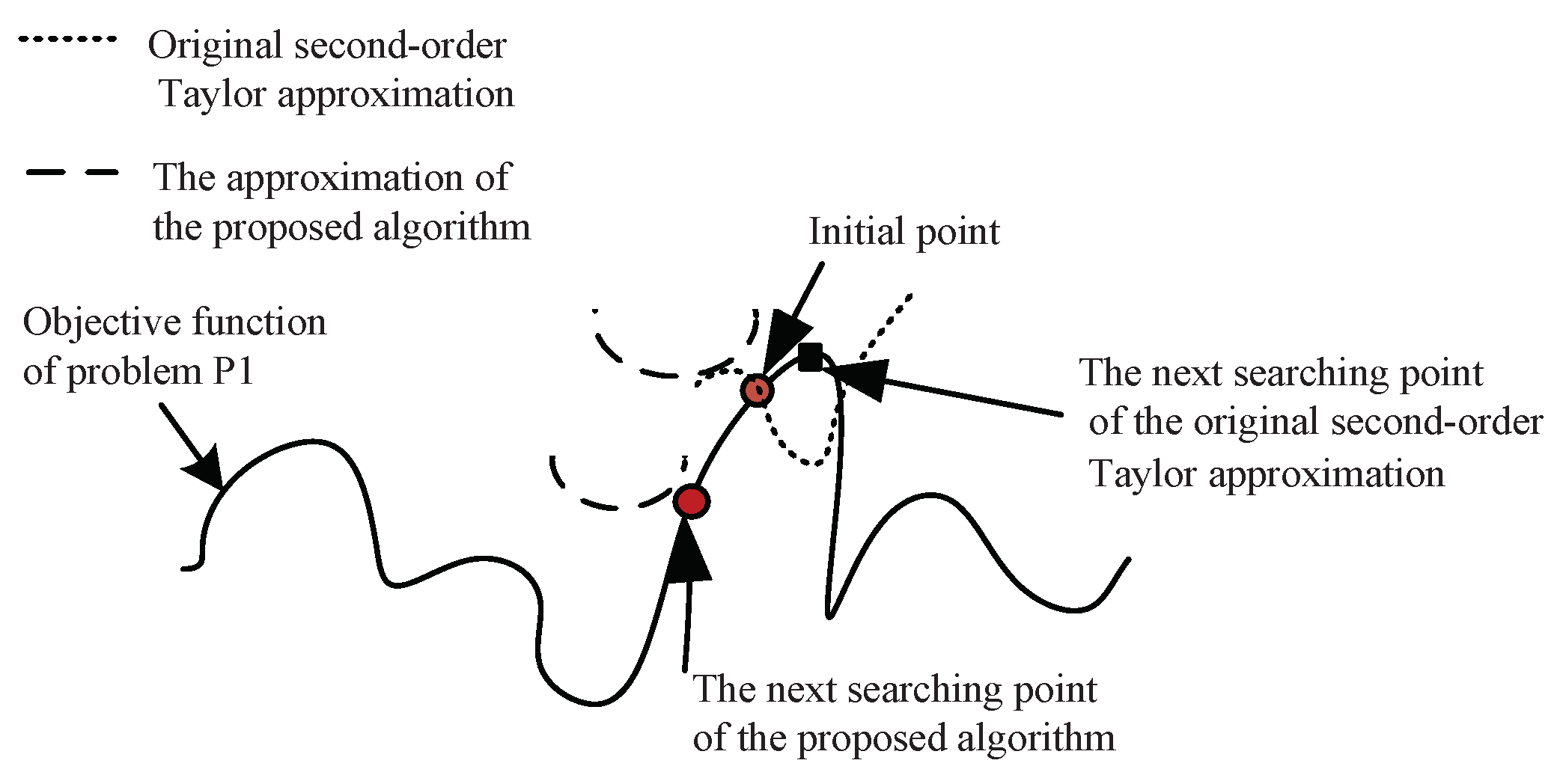
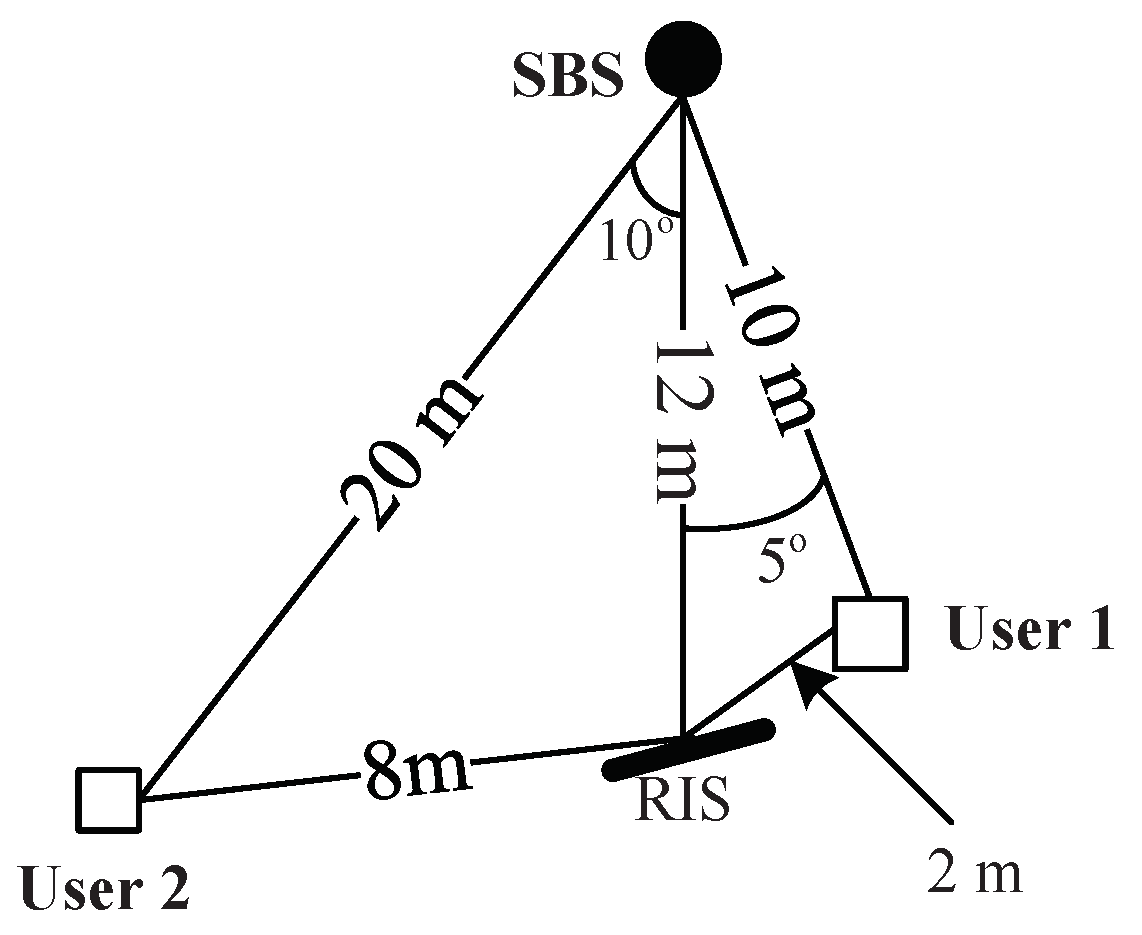
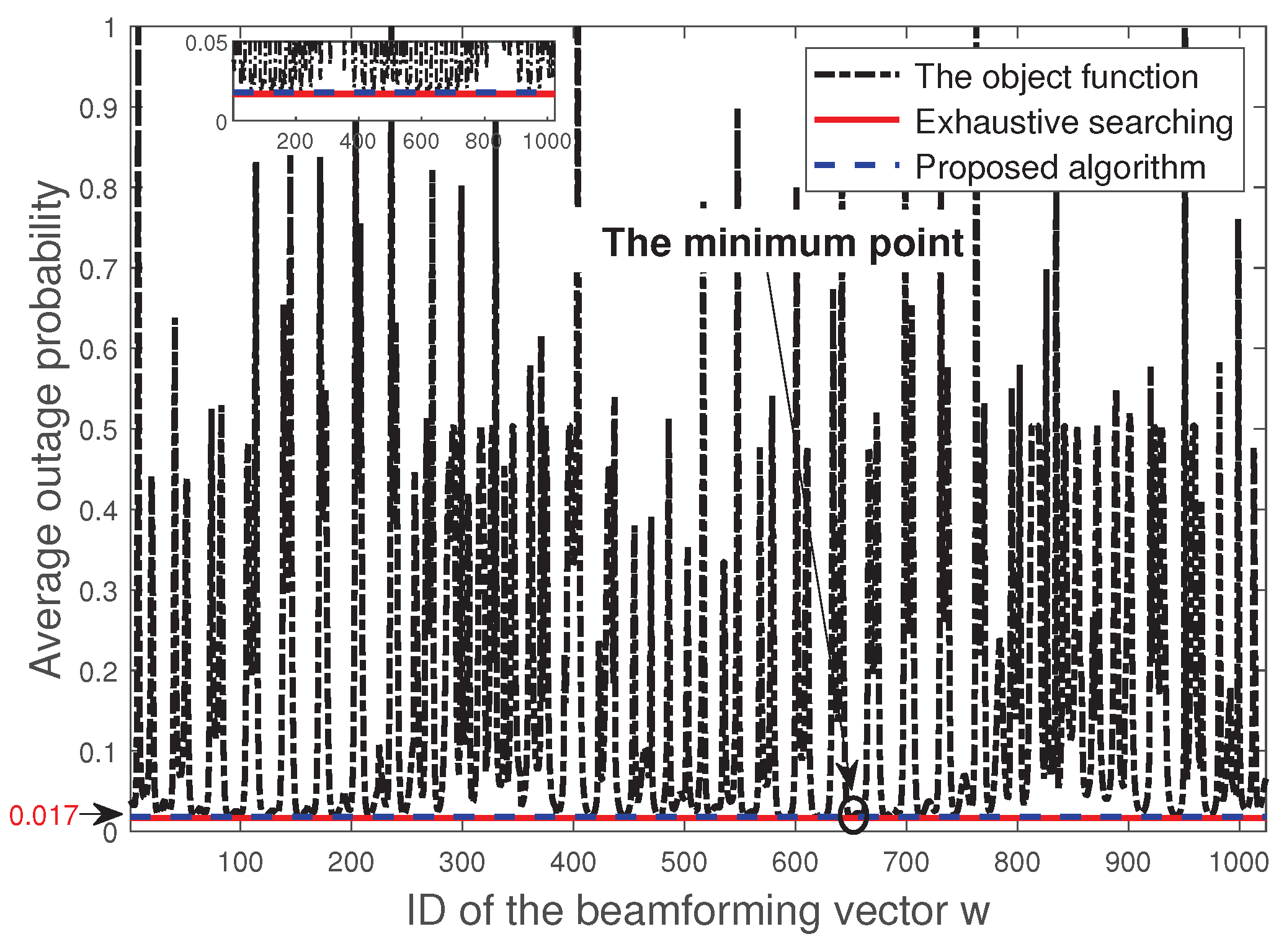
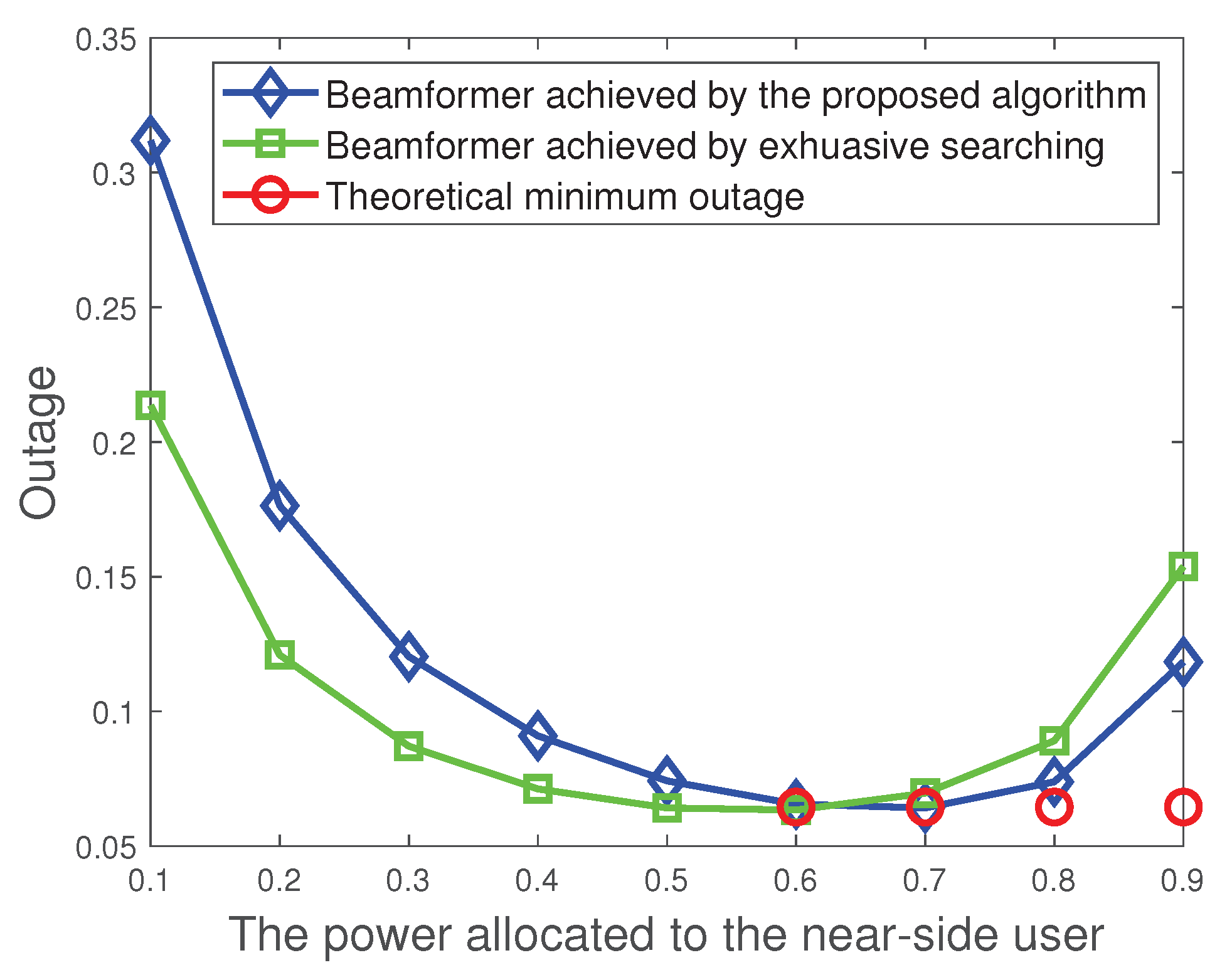


| MEC | mobile edge caching | the received signal | |
| RIS | reconfigurable intelligent surface | the effective channel | |
| SBS | small base-station | r | the spectral efficiency |
| NOMA | non-orthogonal multiple access | the outage probability | |
| UAV | unmanned aerial vehicle | the popularity profile | |
| RHS | right-hand-side | the caching entropy | |
| w.r.t. | with respect to | the average outage probability | |
| exponential distribution parameter | the caching list | ||
| passive beamforming vector | power allocation vector |
| Algorithm Name | Applicable Scenario |
|---|---|
| Newton’s Descent Method | Convex, Unconstrained optimization problems |
| BCD Algorithm | Non convex, Only suboptimal solution |
| The Traditional BSUM | Non convex, Only suboptimal solution |
| The Proposed BSUM | Non convex, Generally optimal with sufficient initial points |
Disclaimer/Publisher’s Note: The statements, opinions and data contained in all publications are solely those of the individual author(s) and contributor(s) and not of MDPI and/or the editor(s). MDPI and/or the editor(s) disclaim responsibility for any injury to people or property resulting from any ideas, methods, instructions or products referred to in the content. |
© 2024 by the author. Licensee MDPI, Basel, Switzerland. This article is an open access article distributed under the terms and conditions of the Creative Commons Attribution (CC BY) license (https://creativecommons.org/licenses/by/4.0/).
Share and Cite
Zhou, X. An Efficient Block Successive Upper-Bound Minimization Algorithm for Caching a Reconfigurable Intelligent Surface-Assisted Downlink Non-Orthogonal Multiple Access System. Electronics 2024, 13, 791. https://doi.org/10.3390/electronics13040791
Zhou X. An Efficient Block Successive Upper-Bound Minimization Algorithm for Caching a Reconfigurable Intelligent Surface-Assisted Downlink Non-Orthogonal Multiple Access System. Electronics. 2024; 13(4):791. https://doi.org/10.3390/electronics13040791
Chicago/Turabian StyleZhou, Xuan. 2024. "An Efficient Block Successive Upper-Bound Minimization Algorithm for Caching a Reconfigurable Intelligent Surface-Assisted Downlink Non-Orthogonal Multiple Access System" Electronics 13, no. 4: 791. https://doi.org/10.3390/electronics13040791
APA StyleZhou, X. (2024). An Efficient Block Successive Upper-Bound Minimization Algorithm for Caching a Reconfigurable Intelligent Surface-Assisted Downlink Non-Orthogonal Multiple Access System. Electronics, 13(4), 791. https://doi.org/10.3390/electronics13040791






